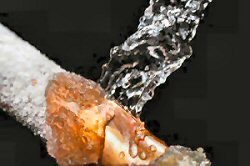Frozen pipes and what to do.
The cold winter can be tough on our water pipes. Just like a lot of other things that we own, our water pipes start to deteriorate with time and use. In the winter months this can be especially true. If you live in a region that experiences below freezing temperature you must take steps to prevent your water pipes from freezing and possibly bursting.
Signs of Frozen Pipes

The most obvious sign that you might have frozen pipes is that there is only a trickle or no water at all coming out when you turn on the faucet. If this happens in very cold temperatures you probably have a water line leading to the faucet that is frozen.
If you see that frost has formed on the outside of the actual water line to the faucet, it usually indicates that the water line is frozen and will require attention before it bursts.
Once you have determined that you have frozen pipes you need to respond quickly to prevent extensive water damage to your property. If you feel you do have to the skills to thaw the pipes, you need to contact a plumber as soon as possible
Frozen Pipes and what should do first.
The very first thing to do if you have a burst pipe with water running is to find the main water cutoff valve for your home and cut the water off. But, it is also important to leave the faucets turned on if you have a frozen pipe. The reason for this is, as the water thaws the open faucet will relieve some of the pressure and may help prevent the pipe from bursting. If you have access and the how to abilities to make at least a temporary repair this will allow you time to bring in a plumber at a later date and make a permanent repair. Allowing a professional plumber to come at their convenience will help you avoid emergency call rates and perhaps get a repair estimate from more than one plumber.
Your primary goal with a frozen pipe is to prevent it from bursting and causing expensive water damage to your home.
Frozen Pipe Prevention
The absolute best way to prevent frozen pipes to to prevent them from freezing in the first place. You can do this by following a few very basic steps.
- Insulate all pipes in the crawl space of your home and all exposed pipes using the appropriate pipe insulation as recommended for your area. Use heat tape if necessary, but carefully follow manufacture’s instructions.
- Keep your thermostat set at a high enough temperature to help prevent your pipes from freezing. It helps protect them from freezing when the walls and floor are warm.
- Seal off all the leaks in your home and crawl space where cold air can enter. Check carefully around electrical outlets and dryer vents.This is especially helpful when there is a cold wind blowing.
- On very cold nights leave a very small trickle of water running through the faucet to help prevent them from freezing.
- If you plan to be away from home for an extended period of time have family or a neighbor check your home often to make sure all is well and the temperature is high enough to help prevent frozen pipes. Better yet just shut off the water going into your home if you plan to be away for awhile.
It is a good idea that everyone in your home knows where and how to cut off the water, in the event of some type of emergency and they are home alone. Water emergencies don’t happen often, but they do happen.
Just a few simple steps taken before the winter months can help to dramatically reduce your changes of having frozen pipes.
